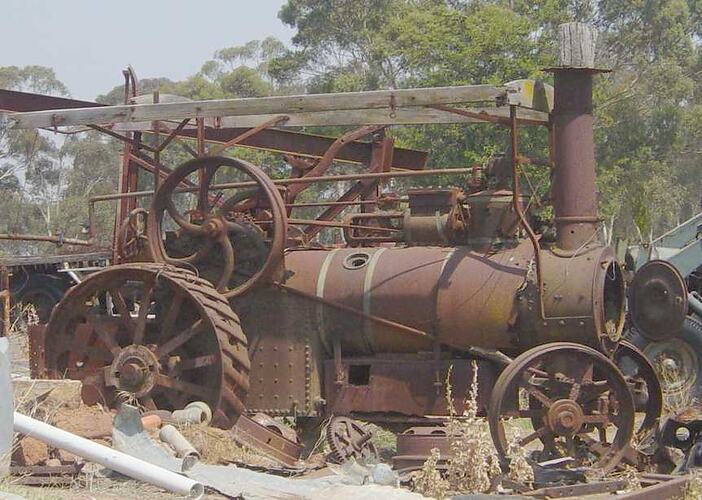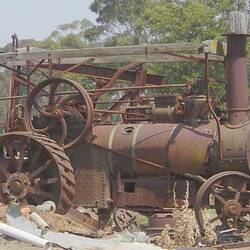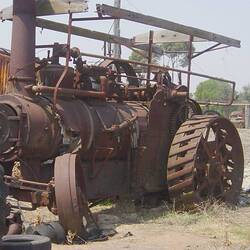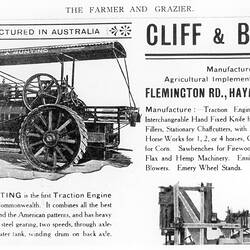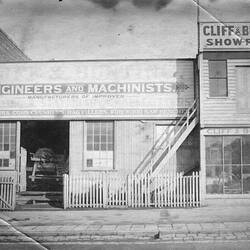Summary
Steam Traction Engine manufactured by Cliff & Bunting Pty. Ltd., of North Melbourne, Victoria, about 1912. Single-cylinder two-speed 8 nominal horsepower general purpose steam traction engine with locomotive style multitubular boiler. Believed to be the only surviving example of around six traction engines built by this firm between 1907 and 1912.
The firm of Cliff & Bunting was established by Harry Cliff and Jonathan Craven Bunting in 1888. Based initially in Elizabeth Street, North Melbourne, they at first specialised in a small range of horse-powered stationary farm machinery including chaffcutters, saw benches, corn crushers, bag fillers and horseworks. In 1895 they acquired the business of a competitor Swan & Co. and relocated their manufacturing works to Swan & Co's larger premises in Blackwood Street, North Melbourne.
In 1897, Cliff & Bunting released their improved "Reliance" model travelling chaff-cutter, which was the first Australian manufactured chaffcutter to feature interchangeable knife-wheels, allowing operators to keep the machine working all day without lengthy delays to re-sharpen the knives or fit replacement knife blades. The "Reliance" set a new benchmark for the performance, reliability and versatility, becoming the machine of first choice for many contract chaffcutters and helped establish Cliff & Bunting's reputation as Australia's leading chaffcutter manufacturer.
In 1902, Cliff & Bunting became the Victorian agents for traction engines built by the O.S. Kelly Manufacturing Co. of Buffalo, New York, which were offered in conjunction with their own travelling chaffcutters as a complete contractor's set-up. This experience appears to have influenced Cliff & Bunting in the design adopted when they began manufacturing their own traction engines following changes to the Commonwealth import tariffs in 1907. The Cliff & Bunting traction engine was first exhibited at the Royal Melbourne Show in 1907 and remained on sale until at least 1912.
The earliest record of the Museum's Cliff & Bunting traction engine comes from Victorian Boiler Inspection records, which indicate that by 1915, it was owned by a contractor based at Caulfield, in Melbourne's south-eastern suburbs. By the 1920s the engine had found its way to Inglewood, in central Victoria, were it was used by Alf Leech for contract chaff-cutting and road haulage - pulling loads such as timber houses, machinery and firewood for the local gold mines. During the 1930s, the engine was acquired by Ernest Jones, who operated a eucalyptus distillery. He initially used the engine for clearing leases in the State Forest stimulating regrowth of the mallee scrub that was harvested for eucalyptus oil production and for harvesting the regrowth foliage. Later the engine was shifted to Jones' eucalyptus distillery on the outskirts of Inglewood, where it was used as a stationary winch for lifting the 'cooked' eucalyptus leaves out of three in-ground distilling pits. By 1950, the eucalyptus distillery had been taken over by Ernest's sons Phil and Albert Jones, who continued to use the Cliff & Bunting traction engine until around the late 1960s. In later years after the traction engine boiler was condemned, steam was piped from a large stationary Cornish boiler in order to keep the engine running.
Physical Description
Self-propelled steam engine with 4-shaft open spur-gear transmission, steam dome, radial-arm single- eccentric reversing gear, curved-spoked flywheel, belly tank, flat-spoked steel-rimmed road wheels and Ackerman steering gear with fixed front axle. Winch drum fitted to rear axle between lefthand rear wheel and firebox.
Significance
The Cliff & Bunting steam traction engine is of central significance to the story of Australia's steam heritage. It is the sole surviving example of the first type of traction engine made in Australia, and as such holds a key role in understanding the development of steam technology in Australia.
Built by Cliff & Bunting Pty Ltd, of North Melbourne, Victoria, around 1912, the engine represents an important landmark in the development of Australian manufacturing. It is one of only two surviving Australian-built traction engines - the other being the Cowley traction engine of 1916, also owned by Museum Victoria. The significance of the Cliff & Bunting traction engine is enhanced by its innovative design combining concepts from both typical British and American traction engine design practices, producing a uniquely Australian product demonstrative of the process of international technology cross-over. The design has added importance because the first engine built by Cliff & Bunting to this design was produced in response to an Australian Government initiative that aimed to stimulate local import replacement manufacturing by the introduction of a selective import duty on traction engines in 1907. Advertising for the Cliff & Bunting traction engine played on the popular "buy Australian" sentiment of the period, proudly proclaiming that it was 'Manufactured in Australia', and emphasising that 'it combines all the best points of the English and American patterns'.
Steam traction engines were one of the most complex and sophisticated pieces of machinery employed in rural Australia during the late 19th and early 20th centuries. From around 1880 until the Second World War they provided a key form of motive power in agriculture, mining, sawmilling and other related industries, as well as being widely used for land clearing and road transport. One of the most distinctive and successful roles played by traction engines was in providing a convenient mobile power source for threshing and chaff-cutting contractors, who were able to employ the engines both for driving their machinery and for hauling their equipment when travelling on the road between farms. During the summer months, dozens of engines could be seen on the country roads of rural Australia, trundling along with a caravan-like procession in tow, including the threshing or chaff-cutting machine, hay elevator, living van and ubiquitous water cart. Teams of itinerant workers moved with the engines from farm to farm, living on the road and maintaining a tough but unique way of live.
Almost all tractions engines used in Australia were imported, however, at least six Australian firms (all based in Victoria) produced small numbers of traction engines locally during the decade between 1907 and 1917. The first traction engines sold in Victoria from the late 1870s onwards were the products of leading British manufacturers such John Fowler & Co., Ruston, Proctor & Co., Marshall, Sons & Co, and Ransomes, Sims & Jefferies, who had all played a role in the early evolution of the traction engine in England during the 1860s and 1870s. By the early 1900s, when the demand for traction engines in Australia peaked, other manufacturers had also entered the market, including several American firms and smaller British companies, some of whom provided stiff competition for the more established brands. In 1902 Cliff & Bunting became selling American traction engines built by the O.S. Kelly Manufacturing Co., of Buffalo, New York, which they offered in conjunction with their own chaff-cutting machines. This experience of selling lightweight American traction engines in a market still dominated by British manufacturers appears to have encouraged Cliff & Bunting to decide that a locally designed engine combining the best features of American and British traction engines might find its own market niche.
Thus the traction engines built by Cliff & Bunting included some components copied directly from the O.S Kelly design - including the steam dome, independent steam cylinder, Pickering governor, radial-arm single-eccentric reversing gear, steel transmission gears and a lightweight tender - while other features such as the heavy duty steel boiler, auxiliary belly tank and full-length canopy owed more to British designs. The strong road wheels adopted by Cliff & Bunting incorporated both American and British features, whilst the Ackerman type steering with a fixed front axke appears to have been completely unique to this deisgn. Evidence from the Victorian Boiler Inspection Records indicate that probably only about 5 to 6 Cliff & Bunting traction engines were built in total, although oral sources suggest that possibly up to a dozen were built in total. The latest record of advertising or promotion of the engines dates from the latter part of 1912.
More Information
-
Collecting Areas
-
Acquisition Information
Purchase
-
Acknowledgement
Purchased with the assistance of the Sunshine Foundation and the Australian Government through the National Cultural Heritage Account.
-
Manufacturer
Cliff & Bunting Pty Ltd, Blackwood Street, North Melbourne, Greater Melbourne, Victoria, Australia, circa 1912
-
Past Owner
-
Past Owner
P. & A Jones, Old Blue Eucy Distillery, cnr Brooke Street or Calder Highway & Grant Street North, Inglewood, Victoria, Australia, 1930s-1950s
-
Brand Names
C&B (Steam Traction Engines) , Cliff & Bunting (Steam Traction Engines)
-
Classification
-
Category
-
Discipline
-
Type of item
-
Overall Dimensions
4850 mm (Length), 2350 mm (Width), 3100 mm (Height), 8500 kg (Weight)
Approximate weight only.
-
Keywords
Eucalyptus Distilleries, Eucalyptus Oil Production, Steam Engines, Steam Traction Engines, Innovation & Design
